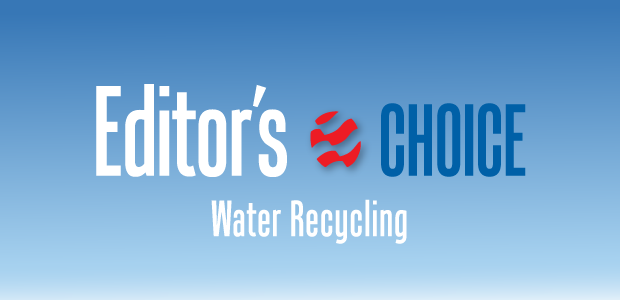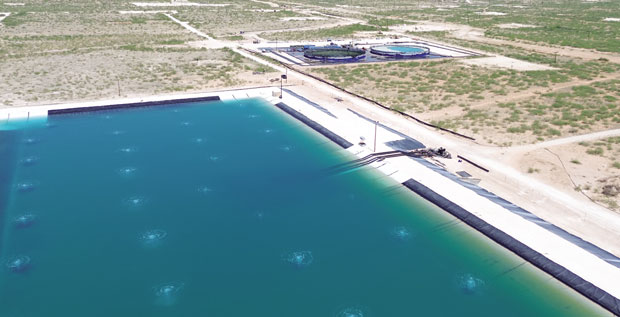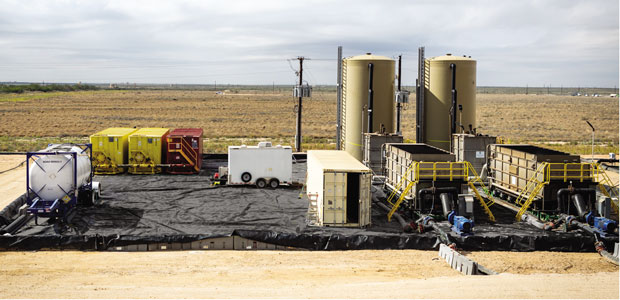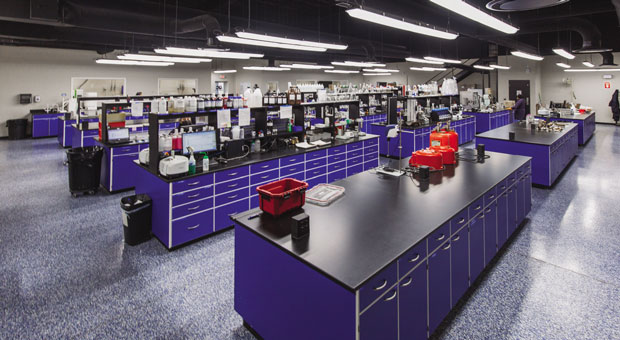
Water Recycling Firms Meet Growing Demand
By Andrew Linnabary
The volume and complexity of produced water continue to grow across major U.S. shale plays, particularly in the Permian Basin, the hotspot of shale production and development activity. Even in newly completed Permian horizontal wells, water-to-oil ratios often exceed 3:1 and can climb much higher. That means, of course, that even in the world’s most prized tight oil resource plays, operators must deal with multiple times more water volumes than oil sales volumes on a daily basis. As much as ever, water is a critical component in the cost equation for extracting a barrel of oil, impacting both upfront capital expenses during the well construction phase and life-of-well operating costs during production operations.
Accordingly, produced water is no longer a secondary concern for operators—it is a central challenge influencing completion logistics, operating economics, environmental strategy, and regulatory compliance. And the challenge is not expected to become any easier to contend with going forward, with experts forecasting that total Permian produced water output will increase by 2 billion barrels annually over the next five years.
The million-dollar question is, how do operators manage growing water flowback and production streams while keeping a lid on treatment and handling costs? The quick answer is to minimize as much as possible the overall cost of the water management cycle while trying to redirect at least part of that stream to reuse applications—namely feeding stimulation operations with frac pump-ready recycled supplies.
Right on cue, service and chemical companies alike are responding with next-generation methodologies to give operators new possibilities for maximizing water management profitability, treatment speed, and sustainability.
The emerging crop of innovations covers everything from real-time digital logistics platforms and advanced biocides to scalable mobile treatment systems and long-term plans for beneficial reuse beyond the oil and gas industry.
Integrated Approach
As the Permian Basin and other major shale plays mature, operators are faced with increasingly complex water management challenges. Select Water Solutions says it is responding with an integrated approach that blends infrastructure, chemistry, automation, and digital intelligence to optimize produced water handling across the entire lifecycle.
Rick McCurdy, Select’s vice president of innovation and sustainability, says the company has invested heavily in infrastructure that enables both the recycling and transportation of produced water at scale. “We are up to 17 recycling facilities across the Lower 48, with several more currently in development, primarily concentrated in the Permian,” he reports.
By building produced water management infrastructure in the Permian Basin and beyond, Select Water Solutions says it is helping producers increase the amount of produced water they recycle rather than inject into saltwater disposal wells. This infrastructure is gaining efficiency thanks to more sophisticated automation and digital tools.
McCurdy adds that these facilities are not only reducing the environmental footprint of operations but also allowing for the strategic reuse of water in multi-well completions to decrease operators’ reliance on fresh water sources.
One of the focal points is digital water intelligence and water balancing to address the Permian Basin’s produced water challenges. Garrett Williams, vice president of corporate finance and investor relations explains, “Water recycling is at the intersection of good stewardship and good economics. We are using technology to take a waste stream and repurpose it for reuse through our water infrastructure operations. Produced water in the Permian basin is a scaled problem that needs a scaled solution. We now have over 3 million barrels a day of recycling capacity that is largely integrated with pipelines and disposal infrastructure. Coupled with our technology and automation, we can make smarter, real-time decisions that deliver cost savings to operators. These technology-supported systems also allow us to optimize water logistics, often routing water through centralized infrastructure networks that reduce trucking needs and related emissions.”
One particular innovation worth highlighting is Select’s water tracking and balancing capabilities through its AquaView® technology and remote operating center. “It is a command center for water. We can track movement, storage, and quality at every stage,” McCurdy notes. The company is also using artificial intelligence to predict water profiles and dynamically adjust treatment and logistics.
In a constantly evolving regulatory environment, these capabilities offer an important edge, McCurdy emphasizes. “States are pushing for more recycling and less disposal,” he states. “Our infrastructure and data backbone let customers capture the value of reusing produced water, meet compliance requirements, and minimize exposure to disposal-related seismicity concerns, which ultimately helps them stay ahead of potential regulatory mandates.”
As it moves forward, the company plans to continue prioritizing multi-operator infrastructure systems, Williams continues. “Our commercialized infrastructure facilities connect our systems to multiple operators, allowing us to balance the long and short water positions across an area to optimize regional reuse. This helps everyone cut costs, reduce disposal volumes, and manage water more sustainably,” he says.
Formulating On The Fly
Finoric, a specialty chemical supplier based in Texas, is taking a custom-engineering approach to its produced water treatment strategy. At the core of the company’s philosophy is the belief that no two basins—or even two wells—are exactly alike when it comes to water chemistry.
“Our biggest strength is our ability to formulate on the fly,” says TJ Tidwell, Finoric’s technical advisor. “We do not come in with a one-size-fits-all solution. We analyze each sample, identify the problem compounds, like iron, barium, or sulfides, and formulate a specific treatment that directly addresses them.”
Finoric does not directly work with produced water and is broadly a base manufacturer of chemicals used in completions, stimulations, and production systems, Tidwell says. Finoric works with service companies that service these segments and offers additional technical capabilities and support when needed.
This flexible methodology has enabled Finoric to offer fast-turnaround chemical programs tailored for reuse, particularly in challenging formations. “We are seeing more operators try to recycle waters with high total dissolved solids (TDS) that present unique challenges,” Tidwell explains. “Our approach helps remove those specific impediments efficiently and economically.”
Another focus is on biocide treatment and growing concerns over microbial control agents. “You cannot just dump glutaraldehyde into a system and hope it works anymore,” Tidwell says. “There has been a lot of data collection to validate differences in biocide efficacy using ATP, and DNA characterization.” The result is optimized dosing, reducing chemical spending and improving outcomes, he notes.
Tidwell says Finoric’s produced water strategy is also being affected by regulatory changes. “Producers are starting to see the economic advantage,” he observes. “We are designing systems that are both effective and easy to document to help clients navigate those changes.”
Looking ahead, the company will continue to focus on logistics, high quality manufacturing, and developing partnerships with service companies “to help elevate their capacities when needed.”
Lifelong Solutions
Produced water treatment continues to evolve as operators look to balance efficiency, sustainability, and regulatory compliance. Tanner Hite, director of unconventional water for ChampionX Chemical Technologies, describes the company’s approach as one that “spans the lifecycle of a well to encompass treatment efforts in produced water reuse, frac water, flowback, and disposal.”
A persistent issue, particularly during flowback, is phase separation. “During completion, you inject a lot of fluids downhole,” Hite says. “This can make it challenging to separate oil and water to get good sellable oil into the pipeline.”
This ChampionX facility uses a mix of chemicals and dissolved air flotation to remove contaminants from produced water efficiently and reliably. The company says its approach spans the lifecycle of a well, with treatment efforts including produced water reuse, frac water, flowback, and disposal."
But while flowback poses challenges, Hite emphasizes a broader lens. “Flowback isn’t differentiated in those challenges. There’s more depth to the produced water challenge.”
One of the biggest hurdles in 2025 is water takeaway, “getting the water where it needs to go, either to dispose of it or recycle it for frac,” Hite explains.
He points to regional data to illustrate recycling’s rise. About 50 percent of produced water is recycled for use during fracing in the Permian Basin, according to the Texas Living Waters Project. Still, Hite cautions, “Reuse for fracing alone will not close the gap as Permian assets are projected to produce more water than ever before in the coming years.”
To address constraints, ChampionX is “designing programs for our customers using fit-for-purpose chemistries that help improve water quality, protecting their valuable assets and lowering their total cost of operations.”
Innovation is incremental but essential. “It’s been a gradual innovation, making small step changes to improve the efficiency and quality of produced water.” At the same time, the industry is experimenting with beneficial reuse: “Can the water be cleaned to a level that would allow us to do things like irrigate crops?
“So, we’re still kind of in a build-out stage.”
Hite concludes with a systems-thinking perspective: “Produced water functions in a cycle. Whatever steps you take throughout that process—or don’t take—have an effect on the rest.”
Ready To Respond
Jacam Catalyst brings a site-specific approach driven by hands-on field support and in-house manufacturing capabilities, according to John Hogan, regional manager for the Permian North region. That strategy is built on direct collaboration with operators and real-time adaptability.
“We are in the field with the lease operator and flowback team, making decisions right there on location,” Hogan says. “That immediacy is critical when the well’s choke is being bumped up and everything changes by the minute.”
Chemicals play a critical role in optimizing separation during the flowback period of a well’s life cycle. Because early production streams’ composition varies widely, Jacam Catalyst says its field teams test every well to tailor treatments to actual challenges. These field teams are backed by local laboratories, such as this one in Gardendale, Tx.
The company specializes in separation chemistries tailored to address the unpredictable nature of early flowback, where challenges range from emulsions and foam to solids, iron, and friction reducers that have not broken down properly, Hogan goes on. “We start with field-based testing at each and every well,” he explains. “There is no ‘one-size-fits-all’ formula—we build treatments for what is actually coming out of the ground at any point in time.”
Emulsion breakers and silicone-based defoamers form the core of Jacam Catalyst’s separation toolkit, ensuring oil and water phases are distinct and can be processed, Hogan explains. The team also works proactively to protect facilities, using iron chelators and scale or corrosion inhibitors early in the flowback cycle.
“We treat the flowlines first if the water analysis or asset history shows risk. The last thing an operator wants is corrosion or scaling in their surface equipment during high-volume production,” Hogan points out.
The company’s comprehensive portfolio also includes advanced surfactants—cationic, nonionic, and anionic—along with a diverse array of biocides and peroxide-based solutions, all customized by application. “Being an in-house manufacturer gives us a serious edge,” Hogan notes. “If something is not working, we do not have to wait days for resupply. We stock and blend locally so that we can pivot immediately.”
An area of growing concern is hydrogen sulfide during the water phase, Hogan reveals. “The H2S load in produced water has increased substantially over the past few years, and takeaway companies are pushing those treatment costs back to operators,” Hogan says. Jacam Catalyst has responded by building a full line of water-treating chemistries specifically for H2S removal, with special attention to dosage control and economic application, he notes.
“We just developed a new H2S treatment chemistry in late May,” Hogan shares. “We are constantly innovating based on what we see in the field—that is our pipeline for new product R&D.”
With flowback and produced water profiles continuing to evolve, Hogan says real-time responsiveness is increasingly a competitive mandate. “Innovation usually comes as a surprise. What is next is whatever the next well throws at us. Our job is to be ready to respond to it.”
For other great articles about exploration, drilling, completions and production, subscribe to The American Oil & Gas Reporter and bookmark www.aogr.com.


















